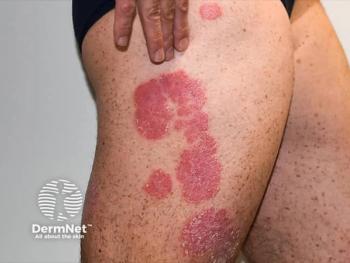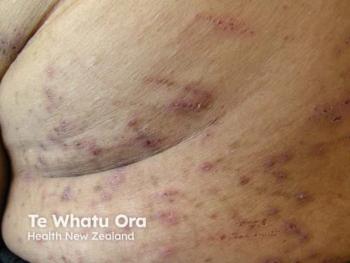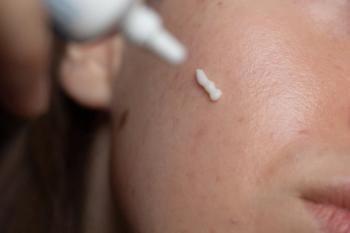
Psoriasis and Cellulitis Burden Has Increased in the US, According to New Posters
Key Takeaways
- Psoriasis incidence increased by 11.7%, with significant demographic and geographic variations, highlighting a need for targeted interventions.
- Cellulitis incidence rose by 18.5%, with a 39.8% increase in mortality, emphasizing the urgency for improved management strategies.
Recent posters at SID revealed significant increases in psoriasis and cellulitis cases in the US, highlighting urgent needs for prevention and treatment strategies.
A team of investigators, comprised of Hossein Akbarialiabad, MD, MSc, HMBA; Christopher Bunick, MD, PhD; Mark Lebwohl, MD; and Ayman Grada, MD, MS, explored US trends of psoriasis1 and cellulitis2 from 2010 to 2021. The posters, which evaluated national and state-level trends in disease burden, were presented at the Society for Investigative Dermatology Annual Meeting, May 7-10, 2025, in San Diego, California. Both skin conditions are common in Americans and can have a profound impact on physical health and psychological well-being. The studies focused on incidence, prevalence, mortality, and disease burden in varying demographic groups across the country.
Methods and Materials
For these trials, incidence refers to the number of new cases during this time period, while prevalence refers to the total number of existing cases in a patient population. The researchers used established methods from the Global Burden of Diseases, Injuries, and Risk Factors Study 2021 to observe age-standardized rates for incidence (ASIR), prevalence (ASPR), and disability-adjusted life years (DALYs) burden per 100,000 population in the US. Bayesian meta-regression modeling was used to analyze national surveys, medical records, and claims data for both conditions.
Key Psoriasis Trends
Incidence has increased by 11.7% since 2010, with 380,893 new cases. ASIR has also risen by 1.89% to 103.97 in recent years. Regarding prevalence, there are now 3.91 million individuals with psoriasis, a 15.7% increase. ASPR rose by 2.29% to 983.50. DALYs also increased by 13.9% to 326,749. This correlates to an ASDR of 83.61 per 100,000, a 1.36% change.
Several trends in age, gender, and location were noted. For example, incidence in children <5 years decreased significantly but remained stable in adolescents. A gradual rise was observed in adults between the ages of 25 and 49. However, the greatest increase was present in adults > 60 years. Interestingly, the female incidence rate declined by 1.52%, while the same rate in males rose by 5.61%. Conversely, females had about 8.45% more prevalent cases than males. The highest incidence was found in the states of Massachusetts, Connecticut, and New York, while the lowest incidence was seen in New Mexico, Utah, and Colorado. These geographic patterns were similar in ASPR and ASDR.
Key Cellulitis Trends
Incidence has increased by 18.5% since 2010, with 10.75 million new cases. This correlates to an ASIR of 2,800.3 per 100,000, a 5.1% increase. Prevalence also rose to 431,912 cases, a 19.7% increase. This indicates an ASPR change of 4.6% (109.8 per 100,000). DALYs also rose by 31.6% to 92,345, which correlates to an ASDR of 19.4 per 100,000, a 10.3% increase. Approximately 3,328 deaths occurred, a 39.8% increase since 2010. ASMR was 0.57 per 100,000, an increase of 11.8%.
There were also several interesting trends in age, gender, and location for this disease analysis. The highest rate of incidence was seen in patients between 80 and 84 years old. Incidence progressively increased with age. Male patients saw higher rates of incidence, prevalence, and DALYs across most age groups. The highest incidence was seen in Louisiana, New York,Alabama, and Missouri, while the lowest incidence wasobserved in Minnesota, Colorado, North Dakota, and Idaho.
Conclusion
Psoriasis burden has steadily increased in the US in recent years, while cellulitis burden rose substantially between 2010 and 2021. Future research can further explore the reasoning behind these varied rates in states and demographic groups. With this literature, the study authors emphasize prevention and treatment strategies, resource allocation, and more timely access to care, especially in regions with higher disease burden.
References
1. Akbarialiabad H, Bunick C, Lebwohl M, Grada A. Psoriasis in the United States: National & State-level Trends in Disease Burden (2010-2021). Poster presented at: Society for Investigative Dermatology Annual Meeting; May 7-10; San Diego, California.
2. Akbarialiabad H, Bunick C, Grada A. Cellulitis in the United States: National & State-level Trends in Disease Burden (2010-2021). Poster presented at: Society for Investigative Dermatology Annual Meeting; May 7-10; San Diego, California.
Newsletter
Like what you’re reading? Subscribe to Dermatology Times for weekly updates on therapies, innovations, and real-world practice tips.


















